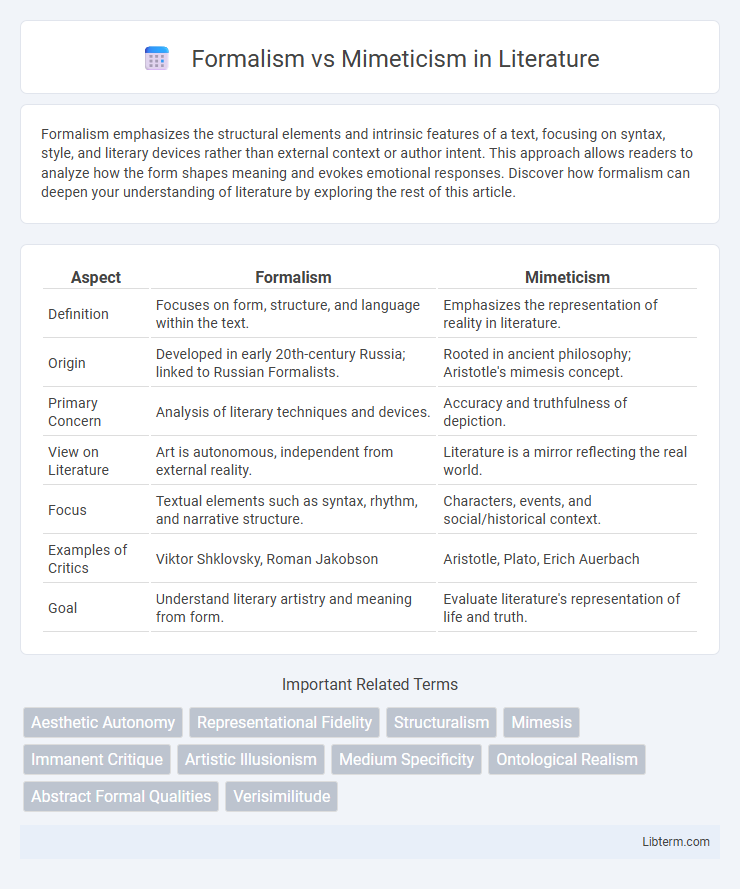Formalism emphasizes the structural elements and intrinsic features of a text, focusing on syntax, style, and literary devices rather than external context or author intent. This approach allows readers to analyze how the form shapes meaning and evokes emotional responses. Discover how formalism can deepen your understanding of literature by exploring the rest of this article.
Table of Comparison
| Aspect | Formalism | Mimeticism |
|---|---|---|
| Definition | Focuses on form, structure, and language within the text. | Emphasizes the representation of reality in literature. |
| Origin | Developed in early 20th-century Russia; linked to Russian Formalists. | Rooted in ancient philosophy; Aristotle's mimesis concept. |
| Primary Concern | Analysis of literary techniques and devices. | Accuracy and truthfulness of depiction. |
| View on Literature | Art is autonomous, independent from external reality. | Literature is a mirror reflecting the real world. |
| Focus | Textual elements such as syntax, rhythm, and narrative structure. | Characters, events, and social/historical context. |
| Examples of Critics | Viktor Shklovsky, Roman Jakobson | Aristotle, Plato, Erich Auerbach |
| Goal | Understand literary artistry and meaning from form. | Evaluate literature's representation of life and truth. |
Introduction to Formalism and Mimeticism
Formalism emphasizes the intrinsic features of a work of art, focusing on structure, style, and form rather than external content or context. Mimeticism centers on the representation of reality, valuing accurate depiction, imitation, and reflection of the natural world or human experience. These contrasting approaches shape critical analysis by prioritizing either aesthetic elements or faithful reproduction.
Historical Origins of the Debate
The debate between Formalism and Mimeticism traces back to ancient Greek philosophy, particularly the contrasting views of Plato and Aristotle on the purpose of art. Plato's Formalism emphasized the ideal forms and abstract qualities of art, while Aristotle's Mimeticism focused on art as an imitation of reality and human action. This foundational discourse shaped centuries of artistic theory, influencing Renaissance, Enlightenment, and modern perspectives on aesthetics and representation.
Defining Formalism in Art and Literature
Formalism in art and literature emphasizes the intrinsic features of a work, such as structure, style, and technique, over content or context. It focuses on elements like composition, color, line, form, and narrative methods to analyze meaning and aesthetic value. This approach prioritizes the formal qualities that make a piece distinct, often disregarding historical or biographical influences.
Core Principles of Mimeticism
Mimeticism centers on the principle that art should imitate reality, emphasizing accurate representation of nature, human experiences, and emotions to evoke a sense of authenticity. Core principles include fidelity to the subject, the replication of details that reflect real life, and the portrayal of universal truths through realistic depiction. This approach values the artist's ability to mirror the external world, fostering a direct emotional connection between the artwork and the audience.
Key Theorists: Formalists vs Mimeticists
Formalism, championed by theorists like Viktor Shklovsky and Roman Jakobson, emphasizes the autonomy of the text and its formal elements such as structure, language, and literary devices, arguing that meaning arises from the composition rather than external reality. Mimeticism, rooted in Aristotle's concept of mimesis and advanced by thinkers like Plato and later realist critics, asserts that literature should imitate or represent reality truthfully to convey meaning and engage the audience. The debate centers on whether the value of a literary work lies in its artistic form or its capacity to reflect and reproduce the external world accurately.
Comparing Artistic Values: Form vs Reality
Formalism emphasizes the intrinsic qualities of artwork, such as color, shape, and composition, prioritizing aesthetic form over representational content. Mimeticism values art's ability to accurately reflect reality, stressing faithful depiction and truth to nature or human experience. The debate contrasts abstract appreciation of artistic elements with the fidelity of imitation, influencing interpretations of meaning and artistic success.
Case Studies: Formalist and Mimetic Works
Formalism emphasizes analyzing works based on structure, style, and intrinsic elements, as seen in Vladimir Nabokov's *Lolita*, where narrative techniques and linguistic play are foregrounded. Mimeticism prioritizes the faithful representation of reality and human experience, exemplified by Gustave Flaubert's *Madame Bovary*, which depicts detailed social environments and psychological depth. These case studies highlight how Formalism concentrates on artistic form, while Mimeticism centers on lifelike portrayal and verisimilitude.
Contemporary Perspectives on the Debate
Contemporary perspectives on the Formalism vs Mimeticism debate emphasize a hybrid approach, recognizing that art's value lies in both its formal qualities and its capacity to represent reality. Scholars highlight how Formalism centers on the intrinsic elements like composition, color, and technique, while Mimeticism prioritizes accurate representation and emotional resonance tied to real-world experiences. Current discourse often explores how digital and interactive media challenge traditional boundaries, blending formal innovation with mimetic storytelling.
Criticisms and Limitations of Each Approach
Formalism faces criticism for its neglect of content and context, often reducing artworks to mere shapes, colors, and composition without considering cultural or historical significance. Mimeticism is limited by its reliance on realism, sometimes undervaluing abstract or interpretive expressions and failing to account for an artwork's emotional or intellectual impact beyond literal representation. Both approaches struggle to fully capture the multifaceted nature of art, with Formalism criticized for abstraction and Mimeticism for oversimplification.
Conclusion: Reconciling Formalism and Mimeticism
Reconciling Formalism and Mimeticism involves acknowledging that art can simultaneously embody structured form and realistic representation, enhancing both aesthetic appreciation and interpretive depth. Integrating formal elements such as composition, color, and technique with mimetic accuracy enriches viewer engagement and emotional resonance. This synthesis fosters a holistic understanding, where the value of art lies in the dynamic interplay between form and content.
Formalism Infographic

 libterm.com
libterm.com